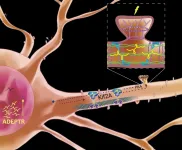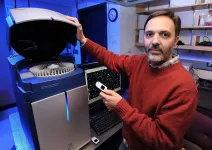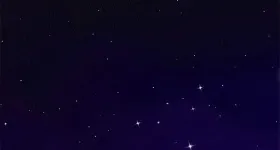(Press-News.org) Research shows that a new telescope could detect a potential signature of life on other planets in as little as 60 hours.
"What really surprised me about the results is that we may realistically find signs of life on other planets in the next 5 to 10 years," said Caprice Phillips, a graduate student at The Ohio State University, who will share preliminary findings at a END
Scientists may detect signs of extraterrestrial life in the next 5 to 10 years
Telescope launching this autumn could spot biosignatures on other planets within three days
2021-04-16
ELSE PRESS RELEASES FROM THIS DATE:
The fate of the planet
2021-04-16
From engineered pandemics to city-toppling cyber attacks to nuclear annihilation, life on Earth could radically change, and soon. Scientists will forecast the fate of the planet at a END ...
Tarantula's ubiquity traced back to the cretaceous
2021-04-16
Tarantulas are among the most notorious spiders, due in part to their size, vibrant colors and prevalence throughout the world. But one thing most people don't know is that tarantulas are homebodies. Females and their young rarely leave their burrows and only mature males will wander to seek out a mate. How then did such a sedentary spider come to inhabit six out of seven continents?
An international team of researchers, including Carnegie Mellon University's Saoirse Foley, set out on an ancestry.com-like investigation to find the answer to this question. They looked to the transcriptomes, ...
On the pulse of pulsars and polar light
2021-04-16
Faced with the tragic loss of the Arecibo observatory in Puerto Rico and the often prohibitive cost of satellite missions, astronomers are searching for savvy alternatives to continue answering fundamental questions in physics.
At a END ...
Neural plasticity depends on this long noncoding RNA's journey from nucleus to synapse
2021-04-16
JUPITER, FL--Making memories involves more than seeing friends or taking photos. The brain constantly adapts to new information and stores memories by building connections among neurons, called synapses. How neurons do this--reaching out arm-like dendrites to communicate with other neurons--requires a ballet of genes, signaling molecules, cellular scaffolding and protein-building machinery.
A new study from scientists at Scripps Research and the Max Planck Florida Institute for Neuroscience finds a central role for one signaling molecule, a long, noncoding RNA that the scientists named ADEPTR.
Using a variety of technologies, including confocal and two-photon microscopy, they track ADEPTR's moves, watching as it forms, travels, amasses at the ...
A new guide for communicating plant science
2021-04-16
AMES, Iowa - A lot is riding on the continued advancement of plant sciences.
Take the food supply, for starters. Climate change and population growth will continue to pose challenges in the future, and crop production will require innovation and progress by plant scientists in order to keep pace. It isn't an overstatement to say that populations around the world will go hungry if plant science stagnates, said Gustavo MacIntosh, a professor in the Roy J. Carver Department of Biochemistry, Biophysics and Molecular Biology at Iowa State University.
"At the end of the day, either you eat plants or you eat food that ate plants," MacIntosh said. "Plants are the basis for the food we have."
MacIntosh predicts ...
The future of particle accelerators is here
2021-04-16
When the Electron Ion Collider received the go-ahead in January 2020, it became the only new major accelerator in the works anywhere in the world.
"All the stars aligned," said Elke-Caroline Aschenauer, Brookhaven National Laboratory Staff Scientist and a leader in developing the EIC plans. "We have the technology to build this unique particle accelerator and detector to do the measurements that, together with the underlying theory, can for the first time provide answers to longstanding fundamental questions in nuclear physics."
The EIC isn't the only Brookhaven project poised to reshape nuclear and particle physics. Forthcoming data from the Relativistic Heavy Ion Collider could finally detect the elusive chiral magnetic effect. Meanwhile, planned accelerators could run on sustainable ...
Simulations reveal how dominant SARS-CoV-2 strain binds to host, succumbs to antibodies
2021-04-16
LOS ALAMOS, N.M., April 16, 2021 -- Large-scale supercomputer simulations at the atomic level show that the dominant G form variant of the COVID-19-causing virus is more infectious partly because of its greater ability to readily bind to its target host receptor in the body, compared to other variants. These research results from a Los Alamos National Laboratory-led team illuminate the mechanism of both infection by the G form and antibody resistance against it, which could help in future vaccine development.
"We found that the interactions among the basic building blocks of the Spike protein become ...
New understanding of the deleterious immune response in rheumatoid arthritis
2021-04-16
Researchers within the Biomedicine Discovery Institute at Monash University have made a breakthrough in understanding the role played by high-risk immune genes associated with the development of rheumatoid arthritis (RA).
The findings, published in Science Immunology, were the result of a seven-year collaboration led by Monash University, involving Janssen Research and Development, USA and the Karolinska Institute, Sweden.
Certain immune system genes, called Human Leukocyte antigen (HLA)-DR4, cause an increased susceptibility to RA. In this study, using mice genetically ...
The Trojan-Horse mechanism: How networks reduce gender segregation
2021-04-16
The social science literature has long viewed homophily and network-based job recruitment as crucial drivers of segregation. Researchers at Linköping University and ESADE, Ramon Llull University now show that this view must be revised. In their Science Advances article, they call attention to a previously unidentified factor, the Trojan-horse mechanism, which shows that network-based recruitment can reduce rather than increase segregation levels.
The segregation of labor markets along ethnic and gender lines is an important source of socio-economic inequalities. Therefore, the understanding the mechanisms that drive segregation ...
Science Advances publishes proteomics technology from Oblique Therapeutics AB
2021-04-16
Science Advances publishes proteomics technology from Oblique Therapeutics AB with a potential to bring several novel antibody medicines to large patient populations in multiple disease areas
Gothenburg, Sweden, April 16th, 2021 - Oblique Therapeutics AB, a Sweden-based biotech company, in collaboration with Karolinska Institutet (Stockholm, Sweden), Gothenburg University (Sweden) and several local biotechs published promising research results in the highly-acclaimed scientific journal Science Advances (AAAS) entitled: Rational Antibody design for Undruggable Targets using Kinetically Controlled Biomolecular ...
LAST 30 PRESS RELEASES:
Longest observation of an active solar region
Why nail-biting, procrastination and other self-sabotaging behaviors are rooted in survival instincts
Regional variations in mechanical properties of porcine leptomeninges
Artificial empathy in therapy and healthcare: advancements in interpersonal interaction technologies
Why some brains switch gears more efficiently than others
UVA’s Jundong Li wins ICDM’S 2025 Tao Li Award for data mining, machine learning
UVA’s low-power, high-performance computer power player Mircea Stan earns National Academy of Inventors fellowship
Not playing by the rules: USU researcher explores filamentous algae dynamics in rivers
Do our body clocks influence our risk of dementia?
Anthropologists offer new evidence of bipedalism in long-debated fossil discovery
Safer receipt paper from wood
Dosage-sensitive genes suggest no whole-genome duplications in ancestral angiosperm
First ancient human herpesvirus genomes document their deep history with humans
Why Some Bacteria Survive Antibiotics and How to Stop Them - New study reveals that bacteria can survive antibiotic treatment through two fundamentally different “shutdown modes”
UCLA study links scar healing to dangerous placenta condition
CHANGE-seq-BE finds off-target changes in the genome from base editors
The Journal of Nuclear Medicine Ahead-of-Print Tip Sheet: January 2, 2026
Delayed or absent first dose of measles, mumps, and rubella vaccination
Trends in US preterm birth rates by household income and race and ethnicity
Study identifies potential biomarker linked to progression and brain inflammation in multiple sclerosis
Many mothers in Norway do not show up for postnatal check-ups
Researchers want to find out why quick clay is so unstable
Superradiant spins show teamwork at the quantum scale
Cleveland Clinic Research links tumor bacteria to immunotherapy resistance in head and neck cancer
First Editorial of 2026: Resisting AI slop
Joint ground- and space-based observations reveal Saturn-mass rogue planet
Inheritable genetic variant offers protection against blood cancer risk and progression
Pigs settled Pacific islands alongside early human voyagers
A Coral reef’s daily pulse reshapes microbes in surrounding waters
EAST Tokamak experiments exceed plasma density limit, offering new approach to fusion ignition
[Press-News.org] Scientists may detect signs of extraterrestrial life in the next 5 to 10 yearsTelescope launching this autumn could spot biosignatures on other planets within three days








